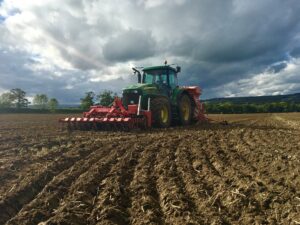After 45 years working for Nickerson I have decided to move on to the next stage of my life, which is retirement.
I thought it was ironic that on my last day on farm I’ve taken a picture of one of the best crops of winter wheat I have seen in my area which happened to be Claire, a winter wheat which must be over 25 years old. It has been a pleasure helping Nickerson to introduce new varieties to the market and hear the success stories of those that we have introduced, too many varieties to mention.


A massive thank you to all my customers, if it was not for your support and loyalty I would definitely not have lasted the 45 years working for the company and I wish you all every success in your future cropping. I know I am very comfortable leaving the business in a very safe pair of hands – those of Douglas Bonn. We have enjoyed meeting most of you over the last three months and he will continue to look after your requirements in the future.
Again thank you for your support I wish you well
Nick Wallace.
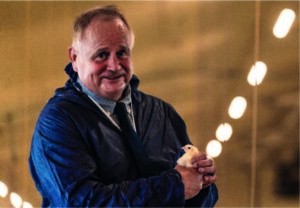
Farms across the country have had a tough time over the last few years growing OSR. Many growers have cut back, and several have removed OSR from their rotation altogether. However, figures from Defra are showing that the area of OSR grown has increased in the Southeast of England. So, do the farms of the south know something the rest of the country does not?
The Southern part of the UK was decimated in 2019 with the OSR crop having the weather and the dreaded Cabbage Stem Flea Beetle (CSFB) against it. Many growers took the hit and swore they would never grow OSR again. However, many have kept going and have learnt to live with this pest.
Growing the correct variety; OSR is a high input crop so choosing a high yielding variety that can offer maximum return is key. LG Armada is the highest yielding OSR variety on the AHDB recommended list. Along with high yield, LG Armada also has pod shatter resistance, Turnip yellows virus resistance along with good resistance to light leaf spot and stem canker. Vigour varies between varieties, some have better Autumn vigour and some better Spring vigour, speak to your local seed specialist to find out which variety will suit you best.
Drilling timing and soil moisture; this is key to a fast establishment farmers that drill into moist seedbeds with rain in the forecast have more of a chance to beat adult CSFB damage, there is no doubt that we go into danger zone when the OSR emerges and then runs out of moisture. We need to be looking at the forecast rather than the calendar.
Companion and trap crops; There has been some anecdotal evidence of success with companion crops, especially when these companion crops are established before the OSR is drilled, the payments that can be claimed through the new Single Farm Incentive makes this even more attracting. OSR volunteers can also act as a trap crop and divert CSFB away from adjacent cash crops. When trap crops are destroyed, CSFB eggs or larvae die. In trials, the approach reduced adult CSFB infestation (by up to 88%) and damage (by up to 76%) in the oilseed rape cash crop. However, benefits were variable and not always observed.
OSR prices rising? Well, there are two things you can never really predict in farming, one being the weather and the second being markets. Prices have come back a long way since the immediate aftermath of Russia’s invasion of Ukraine but are starting to climb again at the time of writing in late May. There are also other reasons for optimism, the EU is set to ban unsustainable palm oil imports this year and this could lead to producers switching to rape seed oil instead, a cut in Canada’s canola production estimate for 2024/25 due to spring acreage shifts to wheat on the back of poor growing conditions has also been supporting prices more recently.
So, there is much reason to be optimistic for a crop that we know works well in cropping rotations, spreads the harvest workload, and has, and can still return a healthy gross margin.
New autumn combinables brochure releasedI am pleased to announce the introduction of the new Nickerson combinables brochure for Autumn 2024, which brings together for the first time Cereals and OSR, in to one easy to navigate book. This brochure should be the go-to document for anyone wishing to gather relevant information to help build their cropping plan for the next sowing season.
Whilst there may be viable alternatives/options within the current version of the SFI for marginal land. Choosing crops and varieties which offer the most economical route to the highest output, is still the biggest driver to whole farm profitability.
This booklet alongside the experience of your regional seed specialist, should help signpost you to the right choice for your situation. Please click HERE to download a digital copy or the ‘find your local Seed Specialist’ button at the top of this page to connect you with someone who will be able to offer solutions to fit your farm, area, market or cropping plan. Seed supply may well be affected this autumn due to the difficult autumn and spring so I would suggest building the plan sooner rather than later, especially for Cereals and key varieties of OSR.
Grant Connor takes over from Marc Lanham in YorkshireI am excited to have started my career at Nickerson, and look forward to getting stuck into my new role as Seed Specialist in glorious Yorkshire.
I will be covering the Yorkshire region from the Humber to the moors of North Yorkshire, heading west across the Pennines and on to the Lancashire border. In my previous role I was involved in the seed potato industry, so with Nickerson I will be swapping seed potatoes for just about every other type of seed!
I grew up in the Scottish Borders surrounded by farms but with no direct links to agriculture until I opted to study it at SRUC in Edinburgh. I embarked on a career in the potato industry, having carried out a placement year with McDonald’s focussing on where their fries come from. I then switched from ware potatoes to seed potatoes. The seed industry has always been of interest to me for two key reasons; Firstly, regardless of the crop type everything in farming starts with a seed; Secondly, my grandfather had a seed business based in the Borders many years ago dealing mainly with grass. Although no longer in existence, I like to think I am carrying on the family tradition!
My area includes a mix of low ground arable farms to upland sheep farms, and I am looking forward to getting to know customers both old and new, and offering seed based solutions to meet the unique challenges thrown up by each farming system.
If I can be of any assistance to farmers in the Yorkshire region, please do not hesitate to contact me on 07734 737008 or grant.connor@nickerson.co.uk
Oilseed Rape Establishment 2023…. What have we learnt?We are all too aware of the damage Cabbage Stem Flea Beetle (CSFB) can cause, it is fair to say that growers who have had no experience with this pest are few and far between and this year was no exception.
We started August with wet weather, which led to some growers drilling early to try and get the crop off and away from Cabbage Stem Flea Beetle. This has largely worked, consequently though there are some big canopies out there, which need to be carefully managed and growth regulators used where necessary.
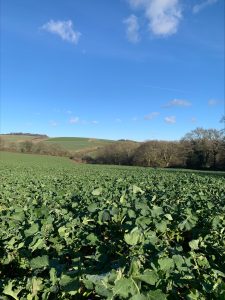
Early August drilled Ambassador near Newbury looking very well and was well enough established to grow through the main adult grazing period of cabbage stem flea beetle
If there is a suspected high larvae count, work by AHDB does show that defoliation either through grazing or flailing can lead to a significant reduction in larvae – although caution needs applied, as this should not be considered after stem extension.
Then we had some hot weather towards the end of August. This undoubtedly drives flea beetle migration and activity, which yet again coincided around the bank holiday weekend. Crops drilled this year, 10 days before and days after the bank holiday weekend have struggled most, from what I have seen.
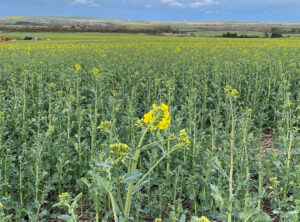
We then had wetter weather after the middle and end of September. This did lead to conducive growing conditions and these crops on the whole look okay, where not underwater. If crops are looking on the thin side, do not be disheartened just yet, OSR has an amazing ability to compensate for lost plants and fill-in gaps.
Slugs seem to have been more of a problem than Cabbage Stem Flea Beetle for some growers this year, thanks to weather conditions driving their activity. They really cannot be underestimated and require extreme vigilance early on.
In many cases, the crops were initially thinned by slugs and then the Cabbage Stem Flea Beetle attacked. The areas most devasted by slug damage are generally on the clay soils. However, the greatest risk and the most damage occurred where crops had been direct drilled with no tillage. In my opinion, any crop direct drilled – be it OSR, cereals or grass seed – increases the risk of slug damage significantly, compared to conventional establishment techniques.
We have all been aware of the cover crops and the use of slurry and digestate to deter the beetles, but I thought by far the most interesting piece of research this year was showing how beetle numbers can be reduced by cultivating the ground straight after harvest and during peak adult migration.
This would also have the added bonus of reducing slug numbers, which are always a significant nuisance to the following wheat crop.
Meet our new seed specialist for the North West, George Hall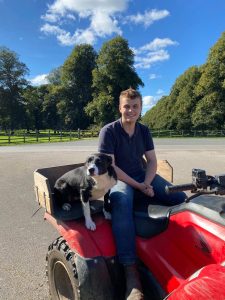 I am delighted to have started my new role as a Seed Specialist at Nickerson.
I am delighted to have started my new role as a Seed Specialist at Nickerson.
I will be covering the North West, North Wales and North Shropshire areas. Since graduating with a BSc Agricultural degree, I had been working on the family farm, which is a 300-acre arable and livestock enterprise where we run 100 Hereford cows and 300 sheep.
We crop approximately 100 acres of the farm annually, this year we will be growing LG Typhoon winter wheat and LG Caravelle winter barley, which will be used on the farm for livestock feed, with excess sold into the feed market.
The livestock enterprise is run with an emphasis placed on maximising daily live weight gain from forage. We improve grazing leys through over seeding on rotation, in addition to including high yielding grass mixtures, as part of the arable rotation for ensiling.
I am excited to meet my customer base throughout the area and assist you with fulfilling your farms’ potential.
If there is anything I can help you with, please do not hesitate to contact me on 07860 590 412 or george.hall@nickerson.co.uk
A word from Sean Lovegreen as we go into harvest 23What a difference a year can make! July 2022 saw a record-breaking temperature of over 400C